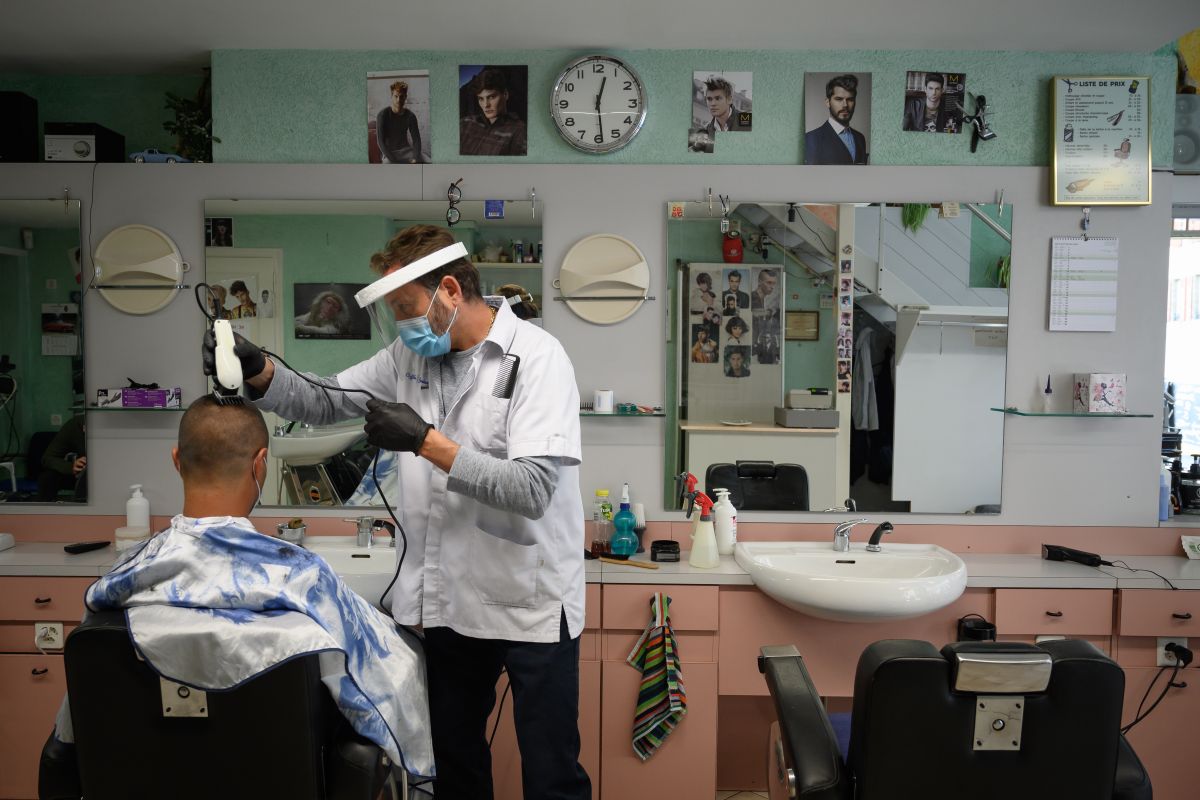Still unexplained
The hunt for the origins of Covid-19 has for the past four years been a tangled web of politics, power struggles, and international finger-pointing.
Well over half of all deaths due to the pandemic are in Europe, with the toll hitting 126,233 on the continent Monday.

A hairdresser wearing a protective face mask and plastic gloves cuts the hair of a customer at Giaquinto hair salon after Switzerland started to ease the restrictions imposed to control the COVID-19 pandemic due to the novel coronavirus, on April 27, 2020 in Lausanne. (Photo by Fabrice COFFRINI / AFP)
The number of coronavirus cases worldwide soared past three million on Monday as New Zealand, several European nations, and a handful of US states began taking steps to reopen their shuttered economies.
After managing to keep the virus from spreading across the country New Zealand moved from level 4 measures to level 3 on Tuesday as Prime Minister Jacinda Ardern was forced to clarify that her country had not eradicated COVID-19 but was working towards its elimination.
Community transmission had ceased, she said, but isolated cases would continue to pop up and would continue “being stamped out” until a vaccine was found. Scientists were working on a vaccine overseas and domestically but a mass roll-out was thought to be at least a year away, she said. Dr Ashley Bloomfield, New Zealand’s director general of health, said “elimination is not a point in time” but something that would have to be consistently worked on.
Advertisement
Meanwhile in Europe, as schools and shops reopened in some parts, British Prime Minister Boris Johnson emerged after his own battle with the virus to call for patience in the UK, saying it was too early to follow suit.
Globally, the infections crossed 3 million and killed around 211,221 people according to Johns Hopkins University data.
Well over half of all deaths due to the pandemic are in Europe, with the toll hitting 126,233 on the continent Monday. With some of Europe’s worst-hit nations reporting drops in daily death counts, governments are exploring how to relax confinement orders exacting their own damaging economic and psychological tolls.
Italy, the first European country to go into lockdown seven weeks ago, began allowing some construction and factory workers to go back to work on Monday. Starting May 4, Italians will be able to exercise outdoors and visit relatives, but only if they respect social distancing and wear masks.
Restaurants can offer takeout and wholesale stores can resume business on the same day, with other shops following on May 18, along with museums and libraries.
General lockdown measures in Austria will expire on 30 April, said the country’s health minister, Rudolf Anschober. He said gatherings of up to 10 people will be allowed, and the main requirement for the public will be to respect distancing rules, reported The Guardian.
In Spain, which began easing one of the world’s tightest coronavirus lockdowns on Sunday, people will be allowed out for exercise and to take walks from May 2.
Spain and France were to announce more detailed plans on Tuesday. France’s lockdown, which started on March 17, will begin to be lifted on May 11, under plans to be unveiled by Prime Minister Edouard Philippe.
Schools will reopen gradually. But the government has already said that restaurants, cafes and cinemas will remain closed for the time being and large public gatherings prohibited.
In Switzerland, Croatia and Serbia, many small shops were back in business on Monday, while children in Norway returned to primary school. Hairdressers, florists, dentists and others went back to work in Switzerland in the first stage of a three-phase plan.
In the United States, several states are rolling back confinement measures that have wiped out tens of millions of jobs. There have been warnings of inadequate testing capacity, but President Donald Trump provided assurances on Monday that testing was being “rapidly” expanded.
“Testing is not going to be a problem at all,” he said at a White House briefing.
A majority of US states do not yet have sufficient COVID-19 testing to consider relaxing stay-at-home orders, according to an analysis by Harvard researchers and the health news site Stat.
Trump also said he expected to see a “lot” of schools open up even if there is not much time remaining in the school year.
While New York Governor Andrew Cuomo sketched out plans to resume some manufacturing and construction activity in low-risk parts of the hard-hit state on May 15, several Republican-led states are speeding up the timeline.
Rejecting the advice of health experts, Georgia has allowed thousands of businesses to resume operations and Governor Brian Kemp said the state’s shelter-in-place order would be lifted on Thursday.
Tennessee permitted restaurants to reopen Monday and Texas Governor Greg Abbott announced that all retail stores, restaurants, movie theaters, malls, museums and libraries would be allowed to reopen on Friday with 25 percent capacity.
Alaska, Oklahoma, Minnesota, Mississippi, Colorado and South Carolina have started to allow certain activities as well. But Californian Governor Gavin Newsom on Monday admonished crowds who flocked to beaches at the weekend.
Plans to ease restrictions have been met with both fear and impatience from citizens facing a deeply uncertain future. Forecasts warn of the worst global recession in a century, with oil prices tumbling and the travel and tourism sector badly hammered.
Germany, which started lifting restrictions last week, has seen small but regular protests against remaining curbs on personal freedom. Starting Monday, masks became obligatory on public transport and in most shops in Germany, a measure residents described as both necessary and irksome.
(With inputs from AFP)
Advertisement